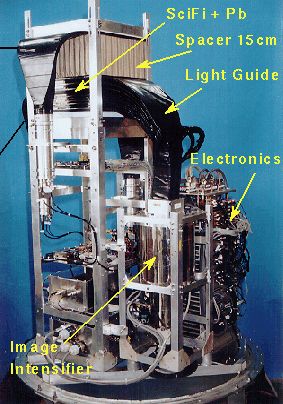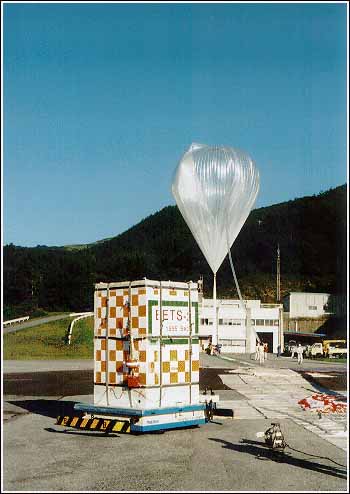Purpose of the flight and payload description
BETS was the acronym for Balloon borne Electron Telescope with Scintillating fibers an imaging calorimeter created for the observation of cosmic primary electrons which was capable of selecting electrons against the large background of protons. The instrument, developed at the Kanagawa University from Japan, had a potential capability of electron identification up to the TeV region with a large acceptance angle.
The figure at left shows a schematic cross-section of the BETS detector. It consisted of a shower detector which incorporated an imaging calorimeter, and trigger, data acquisition, and telemetry systems. The shower detector was composed by 36 layers of scintillation fiber counters. The fiber layers consisted of 18 set of two orthogonal layers. Lead plates were put between each layer in order to produce shower particles, whose positions were detected by fiber counters. The end of the fibers were connected to image intensifiers, and the image output was read out by a CCD (Charge Coupled Device) camera. The instrument was able to detect the three dimensional distribution of shower particles electronically.
The counter system was triggered by three plastic scintillation counters placed at 0, 1.8 and 7.1 radiation lenghts from the entrance of the detector. The diameter of the fiber was 1 mm, and the total number of fibers was 10,080. The signals from each 256 x 256 CCD pixel were digitized by an eight bit AD (analog to digital) converter. The energy range of the detector was 10 to several 100 GeV, and the geometrical factor was about 300 cm2.sr. The incident angle was determined with an accuracy of about 1 degree.
The observed data were stored in EXB 8 mm tape and analyzed after recovery of the instrument. Sample data was telemetered to monitor normal function of the instruments during the flight. The electrons were selected with the conditions that the shower axis was completely inside the detector volume, the zenith angle of the shower axis was smaller than 30 degree, and more than 70% of the total energy was lost within 5 mm from the shower axis.
In order to keep the instrument at constant temperature and pressure, it was contained in a pressurized vessel with a diameter of 1 m and a height of 1.7 m. The vessel made of aluminum has a thickness of 4 mm on the top part to reduce the effects of secondaries particles produced in the covering material. The geometrical factor of 500 cm2 was relatively large with a weight of about 230 kg.
Details of the balloon flight
Balloon launched on: 9/2/1999 at 6:55 jst
Launch site: Sanriku Balloon Center, Iwate, Japan
Balloon launched by: Institute of Space and Astronautical Science (ISAS)
Balloon manufacturer/size/composition: Zero Pressure Balloon model B50 50.000 m3
Flight identification number: B50-45
End of flight (L for landing time, W for last contact, otherwise termination time): 9/2/1999
Balloon flight duration (F: time at float only, otherwise total flight time in d:days / h:hours or m:minutes - ): 6 h 55 m
External references
- A Balloon Borne Electron Telescope with Scintillating Fibers 24th International Cosmic Ray Conference, Vol. 3, held August 28-September 8, 1995 in Rome, Italy
- Atmospheric gamma-ray observation with the BETS detector for calibrating atmospheric neutrino flux calculations Physical Review D, vol. 66, Issue 5
- Scientific ballooning in Japan Advances in Space Research, Volume 30, Issue 5, 2002, Pag.1095
- Scientific observations with balloons Institute of Space and Astronautical Science Annual Handbook 1999 (In Japanese)
1876If you consider this website interesting or useful, you can help me to keep it up and running with a small donation to cover the operational costs. Just the equivalent of the price of a cup of coffee helps a lot.



